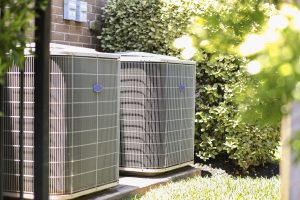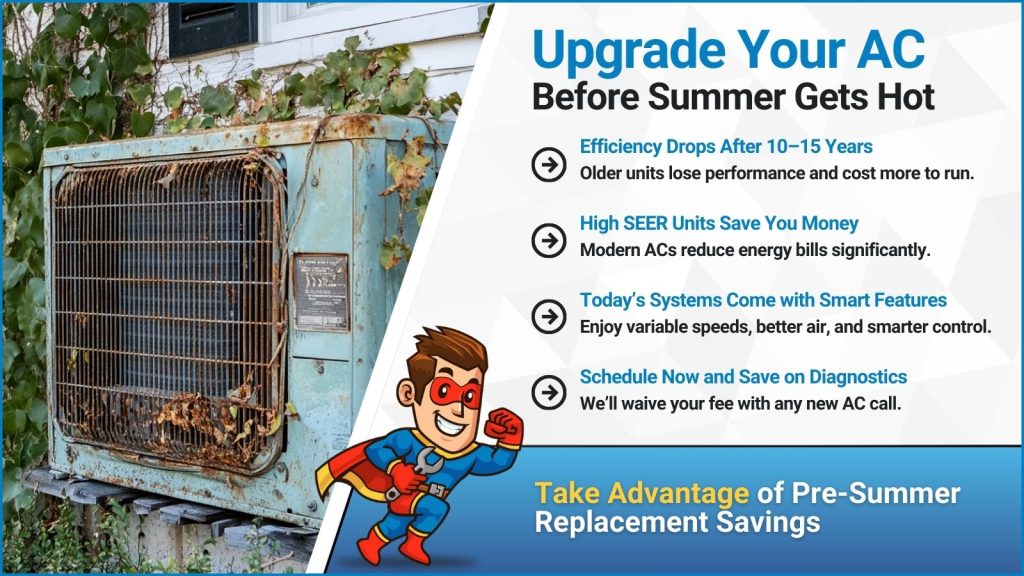
When it comes to home comfort, your air conditioning system plays a crucial role, especially during the sweltering days of summer. But many homeowners face a common dilemma: should you wait until your AC completely breaks down before replacing it, or is it smarter to upgrade around the 10-15 year mark? The answer leans heavily in favor of proactive replacement and here’s why making the switch before failure strikes is a sound financial move.
For your new AC, we’re offering a completely free diagnostic fee with every AC call. Get started on the right foot by ensuring your brand-new AC is taken care of.

Why the 10-15 Year Window Matters
Most air conditioning systems have a lifespan of 10 to 15 years, depending on how well they’ve been maintained. As your system ages, its efficiency gradually declines. Parts wear out, refrigerant becomes harder to source (especially in older R-22 systems), and even routine repairs start adding up. If your AC is nearing or past the 10-year mark, the writing is often on the wall: reliability is decreasing, and operating costs are likely climbing. If you’re noticing problems already, review the top 5 signs your AC system needs repair to assess whether replacement may be the better option.
Waiting until your system breaks down can leave you vulnerable during peak seasons, when HVAC contractors are busiest and emergency replacement costs can be high. On the other hand, replacing your system proactively gives you the luxury of time to compare models, secure competitive quotes, and schedule installation during off-peak times, which may even come with discounts or promotional offers.
The Cost of Holding on Too Long
One of the biggest financial drawbacks of keeping an old air conditioner is the cost of inefficiency. Units manufactured more than a decade ago often have SEER2 (Seasonal Energy Efficiency Ratio) ratings of 10 or lower. Today’s high-efficiency systems boast SEER2 ratings of 16 to 25 or more. That difference can translate into significant monthly savings. If you want to improve system performance in the meantime, consider these tips for boosting AC efficiency this spring to make the most of your current unit.
For example, upgrading from a SEER2 10 unit to a SEER2 18 model can cut cooling costs by up to 44%. Over the course of a single cooling season, that could mean hundreds of dollars in savings especially in hotter climates. Over several years, those savings can quickly offset the cost of the new system.
Additionally, newer units tend to have advanced features such as variable-speed compressors, smart thermostats, and environmentally friendly refrigerants. These not only reduce energy use but can also improve comfort and air quality in your home.
Avoiding the Domino Effect
An aging AC doesn’t just cost more to run it can also cause collateral issues. Frequent breakdowns can lead to expensive emergency service calls, and an overworked system might stress other parts of your home’s HVAC infrastructure. Plus, if your old unit fails in the middle of summer, you could face days without cooling, which can be more than just uncomfortable it can be dangerous for vulnerable household members. To understand the risks of letting your AC deteriorate unnoticed, explore why AC problems aren’t always loud many serious issues are easy to overlook until it’s too late.
Make a Smart Investment
Replacing your air conditioner at the 10-15 year mark allows you to take control of your home’s comfort and your financial future. You can avoid the stress and higher costs of emergency replacement, enjoy lower energy bills, and benefit from newer, more advanced cooling technology. It’s not just a comfort upgrade it’s a strategic, money-saving decision.
For an AC upgrade, schedule an appointment with Mr. Air Repair. Family serving family!
